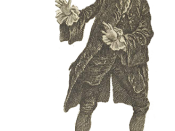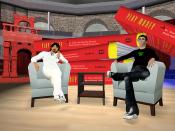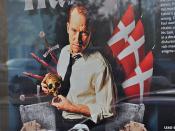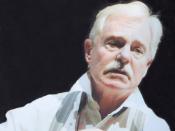Shakespeare's "To be, or not to be" speech can be interpreted in many different ways. In the Gibson, Jacobi, and Branagh versions, senses of depression, contemplation, and vengeance were conveyed. All of the emotions represented by the actors were appropriate, given the mental and physical states of Hamlet in the context of the play.
In the Mel Gibson version, Hamlet was portrayed as a depressed and suicidal individual. He wore a black, leathery outfit, with a small dagger tied around the waist. The setting began with Hamlet descending through chiaroscuro into dark and gloomy catacombs, filled with skulls on the wall and a large sarcophagus. Gibson's gestures included walking through scattered bones while looking around aimlessly, and placing his hands on his chin during "To sleep! perchance to dream!" During this line he also closed his eyes representing the sleep of death itself. His pace started to speed up as his anger grew when he said, "That patient merit of unworthy takes," but returned to his original stride as he collapsed saying "who would these fardels bear."
Emphasis was placed on the line, "Thus conscience does make cowards of us all," which explained Hamlet's anger at his own inability to take his revenge. This interpretation of the speech was possible because of Hamlet's intense grief over the death of his father.
In contrast, the Derek Jacobi version, represented the speech in a much lighter tone. The setting was a bright hallway, and Hamlet wore a white, airy, poet shirt. He reasoned his actions by talking directly to the audience, while Gibson's Hamlet merely looked off into space. Props included in the scene were a chair, a pendant medallion, a small dagger, and a silhouette of Ophelia in the distance. The walls were painted to look as if they were a sunny balcony looking out over a river. During the opening, Derek held himself tightly, representing his efforts to reassure himself in his beliefs. While he said, "When he himself might his quietus make with a bare bodkin," he meddled playfully with his dagger extremely close to his neck, demonstrating to the audience how easy it would be to end all these miseries. Then Derek grasped his pendant, which had a graven image of his father on it, during ".. with this regard their current turn awry." His pace was quicker than Mel's, with his emphasis mainly placed on the lines "the bare bodkin," "enterprises of great pith and moment," and as Gibson did, during his anger, "That patient merit of unworthy takes." This way of interpreting the speech was also appropriate because of Hamlet's status as a student, and as a scholar.
Contrary to its predecessors, the Ken Branagh Hamlet is much more modern. The scene takes place in a very bright and large open room. The floors were made of black and white diagonal tile which represented the beliefs of life and death within Hamlet's own mind. The set contained a one-way mirror, in which the King and Polonius hid behind, and a thin dagger just like in the Jacobi version. Hamlet wore a black suit with a white shirt underneath and his dagger concealed, and had images resembling snakes on is collar and cuffs. The King and Polonius were both dressed in military uniforms, and Ophelia wore a blue gown. During Ken's performance he looked intensely at his reflection for the entire time, never raising his voice above a whisper. He walked slowly towards the mirror, and as he got angrier, started shaking his fist. While he said "To grunt and sweat under a weary life," he quickly drew his dagger, and pointed it as his own reflection-acting as if he was aware of the eavesdroppers' presence. His pace was slow and monotone, mimicking his walk, and his eyes never blinked or looked away for a moment. His emphasis came out when he almost raised his low voice into a normal tone during the lines, "The pangs of dispriz'd love." This explanation the scene was also fitting because of Hamlet's mental disposition at that time.
All these versions depict this famous speech in several distinct ways. Their portrayals were all reasonable, due to the space in the writing that was left for artistic interpretation. The depth of Shakespeare's actors made it possible for versions of the same soliloquy to be conveyed in different fashions, each with its own evidence to support its reasoning.





